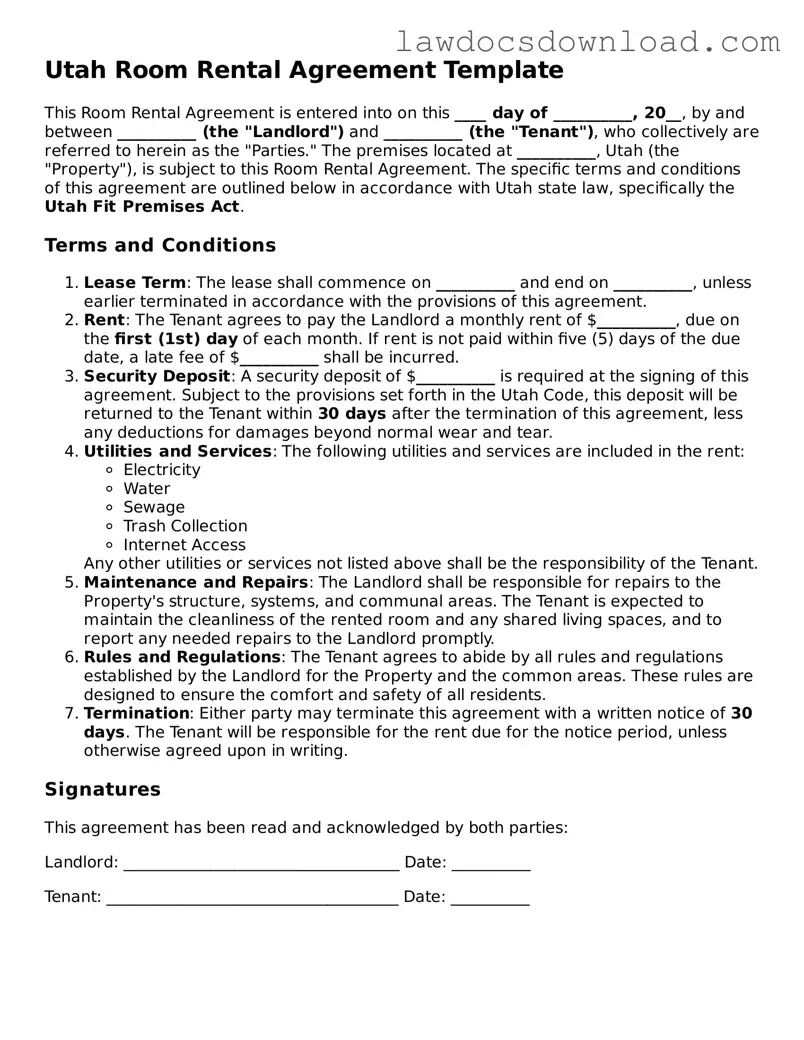Filling out the Utah Room Rental Agreement form requires careful attention to detail to avoid common pitfalls that can lead to misunderstandings or legal issues down the line. One often-seen mistake is incorrectly identifying the parties involved. It is crucial to accurately list the full legal names of the landlord and the tenant to ensure the agreement is legally binding. This includes middle names if they are used on official documents, as any discrepancy can create confusion regarding who is legally responsible under the contract.
Another area where errors frequently occur is in the description of the premises. Some individuals mistakenly offer a vague description of the property being rented. Specifically, when renting out a room, the agreement should clearly describe the exact location of the room within the property, including its dimensions or any distinguishing features, and whether common areas are shared. This detail prevents disputes regarding the extent of the tenant's access and use of the property.
Rental terms are often outlined with ambiguity, leading to potential disagreements. An essential component of the agreement is detailing the length of the tenancy, whether it is month-to-month or for a set term. Including specific start and end dates clarifies expectations and responsibilities. Additionally, failing to specify whether the lease will automatically renew or require a new agreement can lead to confusion at the end of the term.
The payment section is yet another area prone to oversight. Not only should the amount of rent be clearly stated, but the agreement should also outline acceptable payment forms (such as check, cash, or electronic transfer), the due date, and any penalties for late payment. Omitting these details leaves room for discrepancies regarding payment expectations and can complicate financial arrangements.
Security deposits are frequently mishandled in these agreements. Parties often neglect to include the amount of the deposit, the conditions for its return, and whether any portion of it is non-refundable. Clearly articulating these terms upfront can prevent disputes upon the agreement's conclusion.
Not specifying the rules regarding guests is a common mistake. It is important to clarify whether there are restrictions on overnight guests, how long guests can stay, and whether the landlord's permission is required. This ensures both parties have the same understanding and can reduce conflicts related to guest privileges.
Maintenance and repair responsibilities can also be a source of confusion if not addressed properly in the agreement. Without clear delineation of who is responsible for various types of maintenance and repairs, disagreements can arise. This section should outline the tenant's responsibility for keeping the room in good condition and the procedure for reporting any necessary repairs.
There is often a lack of clarity about the rules and regulations that the tenant must follow. Without a detailed list of do's and don'ts, tenants may inadvertently violate terms of the agreement, leading to unnecessary conflict. This can include regulations about noise levels, smoking, and pet policies.
Lastly, omitting a clause on the termination of the agreement is a frequent oversight. It is essential to outline the conditions under which either party can terminate the agreement, including notice periods and any penalties for early termination. This clarity ensures both parties are aware of the process for ending the agreement in a way that is fair and legal.
